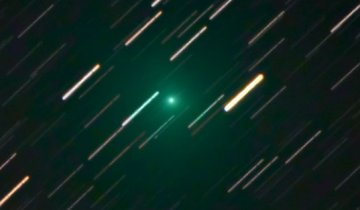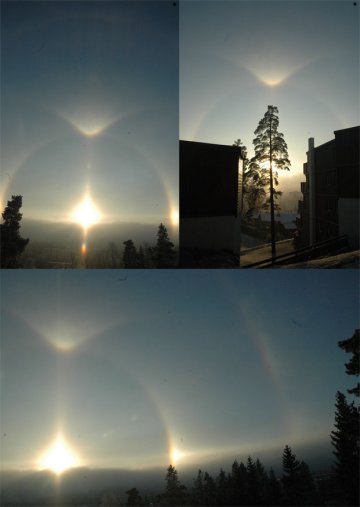 Where's Saturn? Is that a UFO--or the ISS? What's the name of that star? Get the answers from mySKY--a fun new astronomy helper from Meade. Where's Saturn? Is that a UFO--or the ISS? What's the name of that star? Get the answers from mySKY--a fun new astronomy helper from Meade. CHRISTMAS EVE SKY SHOW: Consider it an early Christmas gift: On Dec. 24th the Moon and Mars are putting on a pleasing late-night sky show: full story. URSID METEORS: Comet 8P/Tuttle is coming and it is bringing a meteor shower with it. "We could be in for a Merry surprise on Dec. 22nd when Earth passes through a trail of comet dust," says astronomer Peter Jenniskens of the SETI Institute. Previous returns of Comet Tuttle to the inner solar system have been attended by outbursts of meteors, most recently in 1980 and 1994. During those flurries, dozens of meteors per hour streamed from the constellation Ursa Minor--hence the name of the shower, "the Ursids." 
Above: Comet 8P/Tuttle photographed Dec. 2nd by Chris Schur of Payson, AZ. The magn. 7 comet is now visible through binoculars in the constellation Cassiopeia. [sky map] [ephemeris] [orbit] Although Ursids have a reputation for being faint, "we are not certain about this," says Jenniskens. "Because winter weather keeps many observers indoors, Ursid outbursts have never been widely observed and they may contain a fair number of bright meteors. We have a lot to learn." That's why he hopes sky watchers will keep an eye on the northern sky this weekend; Ursid meteors emerge not far from the north star, Polaris. According to models by Jenniskens and colleagues, the peak will occur around 2100 UT (4 pm EST) on Dec. 22nd with meteors visible as much as four hours before and after that time. Anything could happen, from a dud to a blast. Bundle up and look! HISTORIC HALOS: On December 16th, the skies above Oslo, Norway, stunned onlookers with a display of ice halos that "looks set to go down in halo history as one of the great ones," says atmospheric optics expert Les Cowley. Oslo resident Johannes Froyen describes the scene: "It was a beautiful day with tiny ice crystals falling from a clear sky. As I looked out my window, I was thrilled to see so many arcs and pillars of light." He took these pictures using a Nikon D70: 
The cause of the display was sunlight shining through diamond dust--that is, tiny crystals of ice in the air near ground level. "Diamond dust makes the very best halos," says Cowley. "The Oslo display was widely seen and had several rare arcs. The bright V shaped halo touching the 22 degree halo is an upper tangent arc. Outside that, the brightly colored arc is actually two superimposed halos, a supralateral arc made by horizontal pencil-like crystals and a very rare 46 degree halo made by tumbling crystals." "The season of diamond dust is upon us in the Northern Hemisphere," he says. "Check the sky during the icy dawns and days of the next few weeks!"
2007 Geminid Meteor Gallery
[World Map of Geminid Sightings]
[IMO recap] [meteor alerts] [Night Sky Cameras] | 
